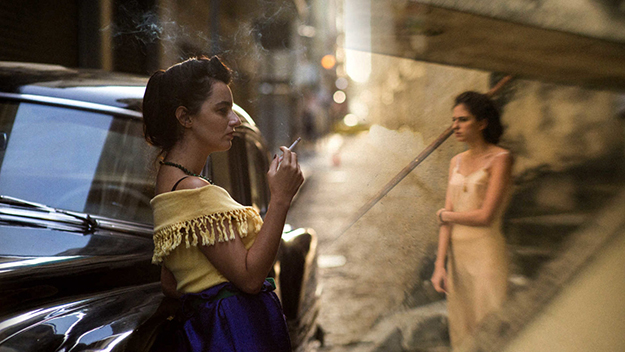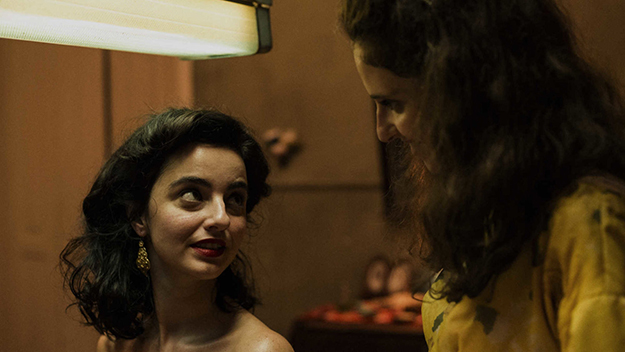Film of the Week: Invisible Life

In a melodrama, you might hope that things will be highly colored. But nothing quite prepares you for the ecstatic, chromatic intensity of Karim Aïnouz’s Invisible Life. To call the film a riot of color doesn’t begin to do it justice: color here doesn’t so much riot as surge, swoon, ebb and flow in a delirious tide of euphoria, and sometimes solemnity. It starts right from the opening sequence, as two sisters explore a forest in Rio de Janeiro, the phosphorescent green of moss on trees chiming vibrantly against the slightly chemical pinky red of the film’s titles. When the end titles come round, the forest foliage has psychedelically turned a lush, decadent crimson.
This might lead you to expect some torrid Almodóvarian fantasia; in fact, Invisible Life is rooted very much in everyday mundanity. Based on the 2016 novel The Invisible Life of Eurídice Gusmão by Martha Batalha, it’s set—apart from a surprise, decades-leaping coda—in 1950s Rio, and tells the story of the two Gusmão sisters. First encountered as teenagers, Guida (Julia Stockler) and the younger Eurídice (Carol Duarte) are daughters of a Portuguese immigrant baker (Antonio Fonseca). They live a comfortable life in their home, although their father’s domination is very much felt, as is the patriarchy in a wider sense: in one scene, Eurídice is required to politely chuckle at the jokes of an older man, a flour merchant that her father is trying to suck up to (and who is presumably being set up as a husband to one of the girls). While the quiet, studious Eurídice cares only for her classical piano practice and the dream of attending conservatoire in Vienna, the independent-minded, sexually curious Guida is sneaking out for trysts with her Greek sailor boyfriend Yorgos, then coming home and telling Eurídice her exploits (a scene that wonderfully captures the mischievous complicity between the sisters).
Guida runs away with Yorgos on his ship, later returning alone, pregnant and rueful but defiant—only to be turned away by her outraged father, with the complicity of her mother (Flávia Gusmão). She is sold the story that Eurídice has left the country, while her sister is none the wiser: she’s now married to the dorkish, oversexed Antenor (Gregório Duvivier). We know from the first shot of her on Eurídice before her wedding that things won’t be great: here she is in her headdress of pearl braids, perched on the toilet taking a nervous pee.
The wedding night is one of the great bad sex scenes in recent cinema—boisterous, farcical and ultimately appalling. It begins with Antenor cracking open poppers for the couple, and leads to deeply ungainly, almost slapstick coupling in a bathtub, preceded by Eurídice laughing her head off at her first ever sight, seen in close-up, of an erect penis (the film reminds us that an erect penis can indeed be a hilarious spectacle, especially with this amount of ungainly wobble). But by the end of the scene, things aren’t so funny: it ends on Eurídice staring into the mirror at herself and Antenor, clearly wondering what the hell just happened and, more worryingly, what the hell lies ahead of her.

Refusing ever again to throw herself on her parents’ mercy, Guida has her baby and bids the middle-class life farewell, working as a cleaner and a factory hand, and finding a landlady who becomes her friend and surrogate mother—retired sex worker Filomena (Bárbara Santos), who has finished with men and can’t understand why the hell Guida won’t. In fact, while neither sister can expect anything lastingly good from the men in their world, they can’t stop hoping for pleasure from them. Guida goes on cruising for hot nights and brief encounters, while even the rows between Eurídice and Antenor—who can’t understand he shouldn’t paw her during her piano practice—seem to end in passionate sex that she enjoys, however sour it feels afterwards. But sex is just one of the forms of rapture that these women hold on as best they can, however fleeting it is. In one scene, as Eurídice loses herself in a piece she plays for a conservatoire audition, Aïnouz cuts in brief inserts of the two sisters, years before, joyously dancing together against green leaves.
I used the term ‘melodrama’ at the start, although it’s by no means certain that Invisible Life is one. You might call it that in the sense that its picture of women’s lives several decades ago echoes the Hollywood ‘women’s pictures’ of the 40s and 50s (rather than the more narratively-loaded Latin American telenovela tradition); the film is constructed on heightened emotional intensity in an everyday domestic milieu, with discreet touches of narrative contrivance playing their part (e.g. the device of a single lost earring), alongside some slightly forced coincidence (a restaurant scene in which the sisters narrowly miss the chance of a surprise reunion).
Otherwise, the film is low on incident, focusing rather on the mundane business of surviving –economic hardship and the tough facts of women’s position in ’50s Brazil. In one scene, Guida and Filomena, as single women, are turned away from a restaurant, their presence considered not sufficiently respectable. In another, Guida applies for a passport to take her son to Europe and search for Eurídice, but is refused unless she can get the child’s father, long out of the picture, to sign the application.

The film manages to make its leads work as teenagers and as somewhat older women battered by harsh experience, and they are both terrific: Stockler’s Guilia is by turns uproarious, tough-edged and painfully poignant, Duarte sometimes playing Eurídice as so surprised by the turns of her life that she seems subject to a permanent shell shock. Duvivier is also compellingly unlikeable as Antenor, the would-be smooth romancer who seems to turn overnight into a stout faded bro in a singlet; his fleshy nude scenes show an admirable lack of vanity.
Aïnouz has previously been known in particular for LGBT-themed films (Madame Satã, Future Beach) but this film concentrates on straight women’s experiences and a concerted critique of patriarchal oppression—something with particular weight in the period depicted, but also highly relevant now under the authoritarian and homophobic new Brazilian regime of Jair Bolsanaro. For these reasons, apart from those brief narrative moments of comedy and ecstasy, Invisible Life might come across as unbearably bleak if not for the lush artifice of its visual aesthetic.
Shot by Hélène Louvart—whose recent work includes Alice Rohrwacher’s differently dream-like Happy as Lazzaro—Invisible Life maintains its visual intensity from start to finish. Aïnouz told me when I interviewed him recently that Louvart warned him he might be going too far with the color, but he insisted on pushing it, and he was right—although some viewers may disagree, and find his approach a distraction. Certainly I defy you to find any obvious consistent color-coding: hues seem to be rather than necessarily mean, except in certain scenes. For example, when Eurídice phones a detective hoping that locate Guida, the receiver is a vivid red in her hand, whether signifying danger or simply urgency. When Guida is first seen on a date with Yorgos, the dancehall turns red and green, echoing the opening sequences, itself becoming a lush erotic jungle; and when Euridice plays her audition piece, her pleasure in the music seems to make her skin glow in rich tones of yellow and scarlet.
Elsewhere, however, color is just color, sometimes seemingly arbitrary but perhaps signifying the redeeming complexity of the world, even when the characters are living through hard times: the greens and yellows of 1950s dresses, a blue and red knitted pillow that glows electrically. Some shots give otherwise realistic images something of the quality of abstract paintings, a touch of Matisse, perhaps: through the window of a kitchen in dusty pink, we see a wall of verdant foliage spiked with purple flowers. Sometimes Aïnouz and Louvert will throw in just a tiny touch of contrasting hue, like a little burst of flame that you may not immediately notice, but that structures the whole image: for example, a green sheet hanging to dry in the distance of an orange night. Visually, the film is a triumph not only for Aïnouz and Louvart, but for colorist Dirk Meier—who’s worth mentioning by name because in general, when it comes to film reviews, colorists really do live invisible lives.
Jonathan Romney is a contributing editor to Film Comment and writes the Film of the Week column. He is a member of the London Film Critics Circle.







